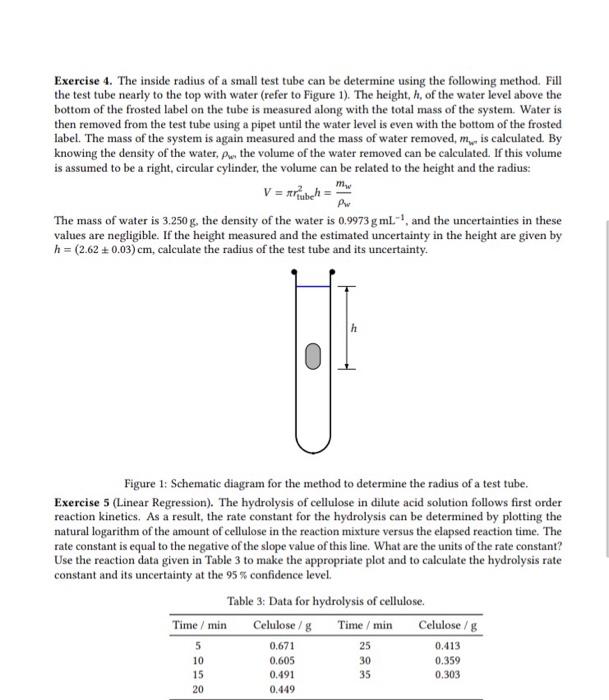Answered step by step
Verified Expert Solution
Question
1 Approved Answer
Exercise 4. The inside radius of a small test tube can be determine using the following method. Fill the test tube nearly to the

Exercise 4. The inside radius of a small test tube can be determine using the following method. Fill the test tube nearly to the top with water (refer to Figure 1). The height, h, of the water level above the bottom of the frosted label on the tube is measured along with the total mass of the system. Water is then removed from the test tube using a pipet until the water level is even with the bottom of the frosted label. The mass of the system is again measured and the mass of water removed, m is calculated. By knowing the density of the water, P the volume of the water removed can be calculated. If this volume is assumed to be a right, circular cylinder, the volume can be related to the height and the radius: V = rubeh : Pw The mass of water is 3.250 g. the density of the water is 0.9973 g ml.-, and the uncertainties in these values are negligible. If the height measured and the estimated uncertainty in the height are given by h = (2.62 + 0.03) cm, calculate the radius of the test tube and its uncertainty. Figure 1: Schematic diagram for the method to determine the radius of a test tube. Exercise 5 (Linear Regression). The hydrolysis of cellulose in dilute acid solution follows first order reaction kinetics. As a result, the rate constant for the hydrolysis can be determined by plotting the natural logarithm of the amount of cellulose in the reaction mixture versus the elapsed reaction time. The rate constant is equal to the negative of the slope value of this line. What are the units of the rate constant? Use the reaction data given in Table 3 to make the appropriate plot and to calculate the hydrolysis rate constant and its uncertainty at the 95 % confidence level. Table 3: Data for hydrolysis of cellulose. Time / min Celulose / g Time / min Celulose /g 0.671 25 0.413 10 0.605 30 0.359 15 0.491 35 0.303 20 0.449
Step by Step Solution
★★★★★
3.48 Rating (165 Votes )
There are 3 Steps involved in it
Step: 1
Exercise 4 Volume mass density 325 g 09973 g mL 32588 mL 32588 cm3 r2h 32588 cm3 Given h 262 003 cm r2 32588 x 262 003 converting the absolute error t...
Get Instant Access to Expert-Tailored Solutions
See step-by-step solutions with expert insights and AI powered tools for academic success
Step: 2

Step: 3

Ace Your Homework with AI
Get the answers you need in no time with our AI-driven, step-by-step assistance
Get Started


